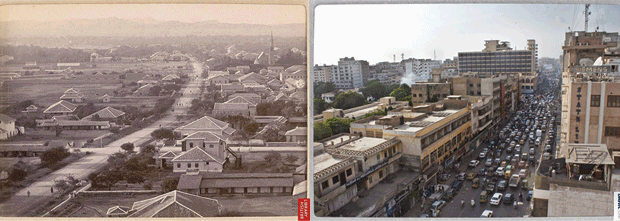|
The population of Karachi grew from around 400,000 in
1947 to approximately 20 million over the period of 65 years. When the
British held complete sway over the subcontinent in the 19th century,
many gothic and renaissance styled buildings were constructed all the
way through the city.
These buildings were mainly located in the Saddar area of Karachi and
still remain famous amongst the people. However, most of them
deteriorated over time due to lack of heritage preservation.
On the other hand a city that stood half empty has developed massively
over the years and the streets that only housed a handful are now
bursting with buildings, people and cars. However the ancient
architecture has not lost its charm over the contemporary construction
that is slowly but surely taking over.
|
|
 |
|
The Empress Market — Constructed between 1884 and 1889, the Empress
Market is one of the busiest and renowned historical structures of
Karachi that traces its origins from the British raj era. The name
commemorates the Empress of India, Queen Victoria. Planned by James
Strachan, the foundations were concluded by the English firm of A.J.
Attfield, and the structure was constructed by the local firm of
‘Mahoomed Niwan and Dulloo Khejoo’. Once a glorious structure and
celebrated shopping bazaar, it is now deteriorating fast due to
negligence and filth.
|
|
 |
East Wharf — Located between Karachi’s towns of Kemari and Saddar, the
port of Karachi is the county’s largest and busiest seaport. The Port
manages about 60 per cent of the nation’s cargo which calculates up to
25 million tons per annum and has seventeen vessel berths.
|
 |
Hotel Metropole — Hotel Metropole was one of the busiest hotels which
catered to the crème de la crème of Karachi. The hotel housed many
celebrities and hosted music sessions featured both national and
international artists. Hotel Metropole, undoubtedly, was one of the most
sought after and busiest tourist spots. The hotel which was known for
hobnobbing with the elites lies now in tatters and is currently being
used as a makeshift parking lot.
|
 |
Karachi Gymkhana was founded in 1886 and served a limited clientele. The
construction of the club depicts Mock Tudor architectural style.
Gymkhana is located at Club Road Karachi which remains one of the
busiest and chicest areas for hotels and restaurants.
|
 |
Clarke Street — A view of a street in the Saddar area of Karachi,
showing the St.Patrick’s Cathedral in the background. St. Patrick’s
Cathedral, the seat of the Roman Catholic Archdiocese of Karachi, is
situated on Shahrah-e-Iraq which was previously known as Clarke Street.
The church was initially built on the grounds of this cathedral in 1845.
|
 |
DJ Science College — Diwan Dayaram Jethamal Science College commonly
known as D J Science College was named after its chief founder in 1887.
It was first established in 1882 under the name of ‘Sindh Arts College’
and was inaugurated by Lord Reay, Governor of Bombay in a lodge on
Bunder Road. Situated in the heart of old Karachi, the foundation was
laid in by Lord Dufferin, Viceroy of India. This year the institute
celebrated 125 years of existence.
|
 |
Zaibunissa Street — Zaibunissa Street was previously known as
Elphinstone Street, in honour of a British official Monstuart
Elphinstone (1779–1859). The Zaibunissa Street with its
Renaissance-style buildings is one of the busiest market streets of
Karachi and features countless shops selling antiquities, clothes and
other artifacts that attract people from all over the world.
|
 |
|
Mohatta Building — This is now the headoffice of the Standard Chartered
Bank on I.I Chundrugar Road.
|
 |
Victoria Road — The long stretch of Victoria Road located near
Elphinstone Street was known for its bustling, busy and full of life
markets. Several architectural delights can be found on the entire road
depicting Gothic, semi-Gothic-and Renaissance-style. The road cuts into
four important sides — from Regal to Bonus Road and from Clark Street to
the Sindh High Court building. However, new construction and
modernization have affected Victoria road greatly.
|
 |
|
Mereweather Tower — Raised by public subscription as a cenotaph for Sir
William L. Merewether, the Merewether Clock Tower was designed by James
Strachen. The tower was designed in Gothic Revival style which was very
common in Victorian London. The foundation was laid by Sir Fergusson,
Governer of Bombay, in 1884 and officially opened to public in 1892 by
Sir Evan James. |